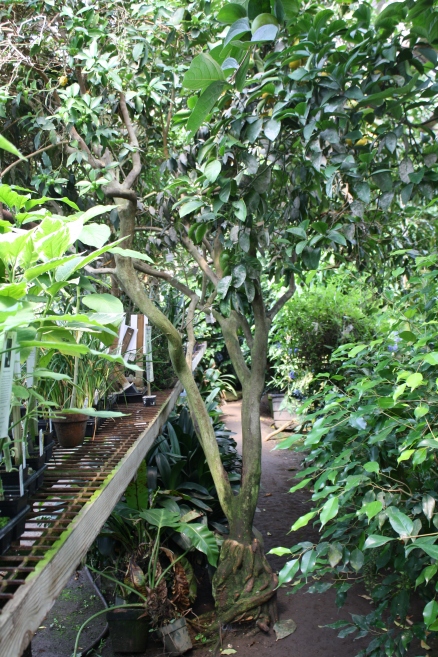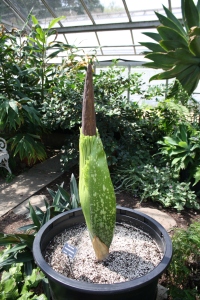
Sumatra, Indonesia, 1940
Amorphophallus titanum, otherwise known as the Titan Arum, is a rare and endangered plant from the rainforest island of Sumatra. In 2009, the URI Botanical Gardens obtained a Titan Arum corm (a bulb-like structure) to add to our tropical plant collection. Now, after two years of vegetative growth alternating with months-long dormant periods, “Audrey” is about to flower!

The Titan Arum, also known as “Corpse Flower” for it’s odor of rotting meat, has the largest unbranched inflorescence in the world. In cultivation it can be 4 to 6, or even 8 feet tall, and more in it’s native habitat. Right now ours is growing about three inches a day. It will keep up this rapid pace until it is ready to open, when growth will slow. The unpleasant smell of the bloom, along with the fleshy red and maroon “meaty” colors, attract the flies and beetles (of the family Sarcophagidae) which pollinate it.

Kingston, RI, August 20 2012
A.titanum was discovered in Sumatra by the Italian botanist Odoardo Beccari in 1878. A specimen was shipped to the Royal Botanical Gardens in England, where the plant was displayed and bloomed for the first time in cultivation in 1889. It may take 15 years for the Titan Arum to become large enough to bloom, and it is especially rare to see in cultivation. According to the UC Davis website, where more than one Titan Arum has bloomed, these giants have been coaxed into flower only about 100 times worldwide. Definitely a first in Rhode Island!

Kingston, RI, August 21 2012

Kingston, RI, August 22, 2012

Kingston, RI, August 23 2012
Our plant has grown 9 inches in three days! In addition to height and circumference measurements, temperature is an indicator of impending bloom time. The temperature of the spadix rises to almost 98 degrees F to help volatilize the “aroma” and attract pollinators. The growth chart and more information is on display in the Conservatory.
As “Audrey” approaches full bloom, visitors to the Horridge Conservatory will have a once in a lifetime opportunity to see a remarkable and unusual sight. Our regular visiting hours w (M – F, 8 am to 4 pm ) will be extended for the 24-48 hours that the flower lasts. Check back for updates and more photos as we track this historic event!

New York Botanical Garden, 1937
 Last week we took a field trip to Logee’s Greenhouse in Danielson, Connecticut. If you are a plant lover who lives in southern New England, Logee’s is probably a familiar name and well worth the trip! They sell fruiting, rare, tropical, and house plants. Oh, and succulents too. There are many unusual varieties and it is hard to describe how absolutely jam-packed the greenhouses are.
Last week we took a field trip to Logee’s Greenhouse in Danielson, Connecticut. If you are a plant lover who lives in southern New England, Logee’s is probably a familiar name and well worth the trip! They sell fruiting, rare, tropical, and house plants. Oh, and succulents too. There are many unusual varieties and it is hard to describe how absolutely jam-packed the greenhouses are. The family owned business has been in Danielson since 1892. The display greenhouses are old cedar or cypress framed glasshouses. The atmosphere is warm and humid with the wonderful fragrance of jasmine filling the air. One greenhouse leads to another in a maze of dirt floors, filtered sunlight, and old stone foundations.
The family owned business has been in Danielson since 1892. The display greenhouses are old cedar or cypress framed glasshouses. The atmosphere is warm and humid with the wonderful fragrance of jasmine filling the air. One greenhouse leads to another in a maze of dirt floors, filtered sunlight, and old stone foundations. We managed to restrain our purchases to only a few plants but it wasn’t easy! I would love to go back in the dead of winter when the green-ness of it would be such an antidote to the grey sleeping garden. To read more about the history of the greenhouses and see their amazing plant selection (also available through mail order) the website is: www.logees.com
We managed to restrain our purchases to only a few plants but it wasn’t easy! I would love to go back in the dead of winter when the green-ness of it would be such an antidote to the grey sleeping garden. To read more about the history of the greenhouses and see their amazing plant selection (also available through mail order) the website is: www.logees.com
























